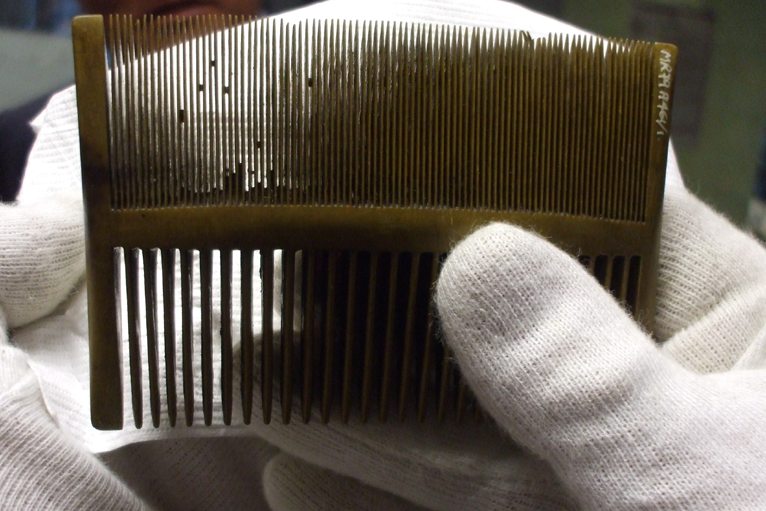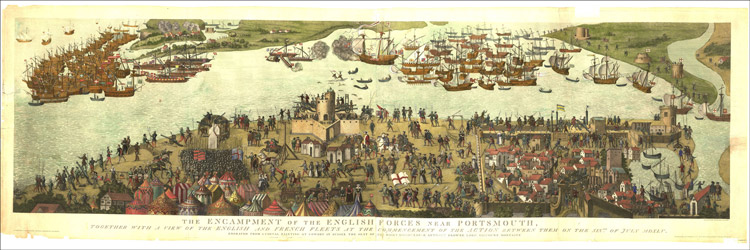Work has started on the £36 million state-of-the-art Mary Rose museum in Portsmouth which will house the flagship of Henry VIII's navy.
The Mary Rose, England's first gunship, was lauched in 1511, just two years into Henry's reign, but was sunk by a French ship (or so the French say) in the Solent, just off Portsmouth, in 1545.
But she was raised in 1982 and has since been housed in the Mary Rose Museum, where her wooden hull is continuously sprayed with a preserving chemical to stop her rotting away.
But the current museum is now seen to be too small to house her and is able to display only 5% of the 19,000 artefacts that were discovered with her. These artefacts include food bowls, beer mugs, medical implements and combs that still have nits in them.
The new museum, due to open in 2012, is intended to resemble a wooden "jewellery box" with timber plank cladding and will be much larger, enabling the public to view more of the artefacts. The public will also be able to get a better view of the Mary Rose herself. Currently, she is always enveloped in a mist due to the spraying, but between 2012 and 2016 controlled air drying will preserve the ship. In 2016, the 34-year project to preserve the timbers will be complete.
Henry VIII is known as the Father of the Royal Navy. At the start of his reign in 1509, the English navy had just 5 ships but, by the end of his reign in 1547, it had about 80 ships. Between 1511 and 1512 Henry also established Deptford and Woolwich as the Royal Dockyards. 300 years later, the Royal Navy would be the world's most powerful naval force.
The Mary Rose, the pride of Henry's fleet, was sunk during the Battle of the Solent between the English and French in 1545 during the Italian Wars.
In that year, King Francis I of France launched a fleet to invade England - a fleet which was larger than the Spanish Armada would be in 1588 -with 200 ships and 30,000 soldiers. In contrast, the English had just 80 ships and 12,000 soldiers.
The battle took place in the Solent, the channel off the south coast of England between Hampshire and the Isle of Wight. On 19th July 1545 as the Mary Rose, the flagship of Vice Admiral George Carew, advanced to battle she foundered and sank with the loss of all but 35-40 of her crew. But the exact cause of her sinking is still not known. The French, of course, say it was one of their ships which sank her, but experts say she may actually have been hit by a strong gust of wind, keeled over and took in water through the open gunports.
A French invasion force had also landed on the Isle of Wight sometime in July but were defeated, and forced to retreat, by local militia in the Battle of Bonchurch. France had tried many times over the centuries to take the English island but were never successful and 1545 would prove to be their last attempt (but a power-hungry megalomaniac named Napoleon would have the nerve to try to invade the whole of Britain almost 300 years later)
Whilst she sank Henry VIII watched horrified from the shore. The battle was a draw, although the French didn't manage to invade England.
The Italian Wars took place due to a dispute between the then two greatest European powers - France and the Holy Roman Empire. The leaders of both powers laid claim to the Duchy of Milan. England took the side of the Holy Roman Empire and the Ottoman Empire took the side of France.
Work starts in Portsmouth on £36m Mary Rose museum
12th Octover 2010
BBC News

The museum will take the form of a finely crafted wooden "jewellery box", clad in timber planks
Work has started on a new £36m museum for the Mary Rose ship at Portsmouth dockyard.
The building will bring the hull of the ship and its 19,000 artefacts under the same roof for the first time since they were brought up from the seabed.
Construction comes on the 28th anniversary of the raising of the Mary Rose watched by a worldwide audience.
The Heritage Lottery Fund has provided £21m for the project with the Mary Rose Trust finding the remainder.

How the Mary Rose looked

This comb, one of 19,000 objects that were found with the Mary Rose, still has head lice embedded in it
The new museum, due to open in 2012, is intended to resemble a wooden "jewellery box" with timber plank cladding.
It will replace the current temporary museum which has space to display only 5% of the Tudor items recovered with the wreck.
During construction the Mary Rose will be out of view to the public.
But when the museum reopens, the preserving chemical sprays that have kept the hull shrouded in mist will be gone.
The ship will be on display during the final phase of conservation, controlled air drying, until 2016 when the 34-year project to preserve the timbers will be complete.
Rear Admiral John Lippiett, chief executive of the Mary Rose Trust, said: "The significance of the Mary Rose collection cannot be underestimated and we still have a £4m fundraising target to meet before the museum can be opened to the public in 2012, the UK's Olympic year.

The hull of the Mary Rose has to be sprayed with a preserving chemical to maintain the timbers
"One year on since the launch of the Mary Rose Public Appeal we remain reliant on the public to continue to ensure this national treasure is preserved for future generations."
Philippe Jouy, from contractors Warings, said: "This is a unique project which will pose some unique challenges for our dedicated team.
"Not least is the immense care required to build a modern museum around the precious timbers of the ship as the final stages of its conservation continues."
The Mary Rose is the only 16th-century warship on display anywhere in the world.
The ship, one of Henry VIII's favourites, was launched in 1511 but sank during a battle with France in 1545.

The 1545 Battle of the Solent, during which the Mary Rose sank
news.bbc.co.uk
The Mary Rose, England's first gunship, was lauched in 1511, just two years into Henry's reign, but was sunk by a French ship (or so the French say) in the Solent, just off Portsmouth, in 1545.
But she was raised in 1982 and has since been housed in the Mary Rose Museum, where her wooden hull is continuously sprayed with a preserving chemical to stop her rotting away.
But the current museum is now seen to be too small to house her and is able to display only 5% of the 19,000 artefacts that were discovered with her. These artefacts include food bowls, beer mugs, medical implements and combs that still have nits in them.
The new museum, due to open in 2012, is intended to resemble a wooden "jewellery box" with timber plank cladding and will be much larger, enabling the public to view more of the artefacts. The public will also be able to get a better view of the Mary Rose herself. Currently, she is always enveloped in a mist due to the spraying, but between 2012 and 2016 controlled air drying will preserve the ship. In 2016, the 34-year project to preserve the timbers will be complete.
Henry VIII is known as the Father of the Royal Navy. At the start of his reign in 1509, the English navy had just 5 ships but, by the end of his reign in 1547, it had about 80 ships. Between 1511 and 1512 Henry also established Deptford and Woolwich as the Royal Dockyards. 300 years later, the Royal Navy would be the world's most powerful naval force.
The Mary Rose, the pride of Henry's fleet, was sunk during the Battle of the Solent between the English and French in 1545 during the Italian Wars.
In that year, King Francis I of France launched a fleet to invade England - a fleet which was larger than the Spanish Armada would be in 1588 -with 200 ships and 30,000 soldiers. In contrast, the English had just 80 ships and 12,000 soldiers.
The battle took place in the Solent, the channel off the south coast of England between Hampshire and the Isle of Wight. On 19th July 1545 as the Mary Rose, the flagship of Vice Admiral George Carew, advanced to battle she foundered and sank with the loss of all but 35-40 of her crew. But the exact cause of her sinking is still not known. The French, of course, say it was one of their ships which sank her, but experts say she may actually have been hit by a strong gust of wind, keeled over and took in water through the open gunports.
A French invasion force had also landed on the Isle of Wight sometime in July but were defeated, and forced to retreat, by local militia in the Battle of Bonchurch. France had tried many times over the centuries to take the English island but were never successful and 1545 would prove to be their last attempt (but a power-hungry megalomaniac named Napoleon would have the nerve to try to invade the whole of Britain almost 300 years later)
Whilst she sank Henry VIII watched horrified from the shore. The battle was a draw, although the French didn't manage to invade England.
The Italian Wars took place due to a dispute between the then two greatest European powers - France and the Holy Roman Empire. The leaders of both powers laid claim to the Duchy of Milan. England took the side of the Holy Roman Empire and the Ottoman Empire took the side of France.
Work starts in Portsmouth on £36m Mary Rose museum
12th Octover 2010
BBC News

The museum will take the form of a finely crafted wooden "jewellery box", clad in timber planks
Work has started on a new £36m museum for the Mary Rose ship at Portsmouth dockyard.
The building will bring the hull of the ship and its 19,000 artefacts under the same roof for the first time since they were brought up from the seabed.
Construction comes on the 28th anniversary of the raising of the Mary Rose watched by a worldwide audience.
The Heritage Lottery Fund has provided £21m for the project with the Mary Rose Trust finding the remainder.

How the Mary Rose looked

This comb, one of 19,000 objects that were found with the Mary Rose, still has head lice embedded in it
The new museum, due to open in 2012, is intended to resemble a wooden "jewellery box" with timber plank cladding.
It will replace the current temporary museum which has space to display only 5% of the Tudor items recovered with the wreck.
During construction the Mary Rose will be out of view to the public.
But when the museum reopens, the preserving chemical sprays that have kept the hull shrouded in mist will be gone.
The ship will be on display during the final phase of conservation, controlled air drying, until 2016 when the 34-year project to preserve the timbers will be complete.
Rear Admiral John Lippiett, chief executive of the Mary Rose Trust, said: "The significance of the Mary Rose collection cannot be underestimated and we still have a £4m fundraising target to meet before the museum can be opened to the public in 2012, the UK's Olympic year.

The hull of the Mary Rose has to be sprayed with a preserving chemical to maintain the timbers
"One year on since the launch of the Mary Rose Public Appeal we remain reliant on the public to continue to ensure this national treasure is preserved for future generations."
Philippe Jouy, from contractors Warings, said: "This is a unique project which will pose some unique challenges for our dedicated team.
"Not least is the immense care required to build a modern museum around the precious timbers of the ship as the final stages of its conservation continues."
The Mary Rose is the only 16th-century warship on display anywhere in the world.
The ship, one of Henry VIII's favourites, was launched in 1511 but sank during a battle with France in 1545.

The 1545 Battle of the Solent, during which the Mary Rose sank
news.bbc.co.uk
Last edited: